Velocity Micro ProMagix HD60: Price/Performance Champ—Again!
The newest ProMagix HD60 from Velocity Micro sets performance records.
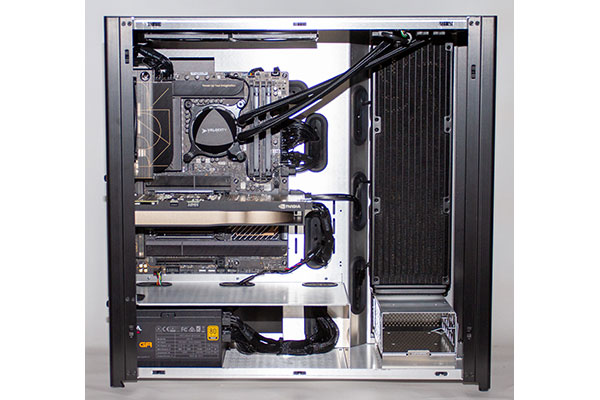
The thin side panel simply unsnaps to access the very roomy interior. Images courtesy of David Cohn.
Latest News
January 8, 2024
It seems that each year we receive a new version of the Velocity Micro ProMagix HD60 tower workstation. Each time we do, the computer turns in top results.
Last year, we looked at a system based on a 12th-generation Intel processor (tinyurl.com/5akts5py). This time around, the Richmond, VA-based system integrator sent us a new ProMagix HD60 that included the latest 13th-generation Intel Core i9 CPU.
The new Velocity Micro ProMagix HD60 workstation came housed in a large charcoal gray tower case, measuring 9.06x20.62x20.0-in. (WxDxH) and weighing 28 lbs., with no handles to lift the system. The front of the monolithic case provides no external drive bays or ports. Instead, a small rectangular power button, a pair of USB 2.0 Type-A ports, a USB 3.2 Type-C port, plus microphone and headphone jacks are located on the top of the case, set several inches back from the front edge. A pair of cooling fans are also visible below vents on top of the case and the fans and the Velocity Micro logo near the bottom of the front panel glow blue when the system is powered up.
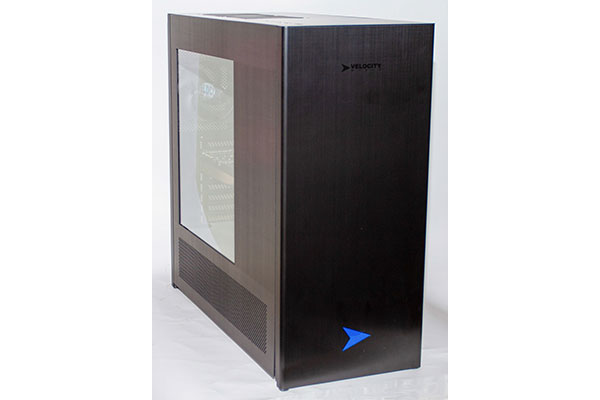
Although the system ran quiet most of the time, its fans were always noticeable above the ambient background noise in our office and peaked at 75dB under heavy compute loads.
The GX6 rear case housing the system provides six additional USB 3.2 Type-A ports and two more USB Type-C/Thunderbolt 4 ports, as well as a pair of RJ-45 ports (one Marvell AQtion 10Gb and one Intel 2.5Gb) for the integrated 10/100/1000MBps gigabit ethernet network adapter. There are also antenna connectors for the built-in Wi-Fi and five audio jacks (microphone, line-out, line-in, rear speaker, and center/sub-woofer).
The thin left-side panel with a large window etched with the Velocity Micro name and logo is held in place with 10 snap connectors, with the blue glow from the interior of the case clearly visible through the window. Once removed, you have complete access to the very well-organized interior with two internal drive bays, none of which was filled. During our review, Velocity Micro informed us that with its GX6 case in short supply, the company had switched to a new SX3 case, a no-cost upgrade over the previous case, which offers even more drive capacity.
Lots of Options
The Velocity Micro website actually lists four different versions of the ProMagix HD60. Customers have a choice of AMD or Intel CPUs and can order systems housed in mid-tower or full-tower cases. The unit we received was a full-tower Intel-based system. The base price of $2,029 gets you a computer with a 3.5GHz Intel Core i5-13600K 14-core CPU, 32GB of RAM, an NVIDIA Quadro T400 GPU and a 500GB Crucial P3 Plus NVMe M.2 SSD. But that price does not include a keyboard or mouse and comes with a 1-year limited warranty.
For our evaluation, however, the system that Velocity Micro sent us included some significant upgrades.
Place Image here.
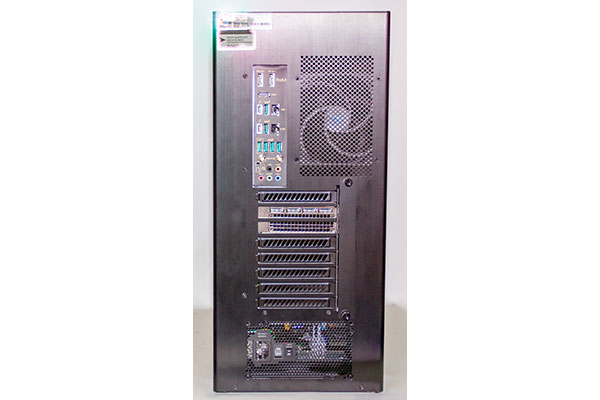 Rear panel of the Velocity Micro ProMagix HD60 provides lots of connections.
Rear panel of the Velocity Micro ProMagix HD60 provides lots of connections. For example, while the base configuration includes an ASUS Prime Z790-A motherboard, the system we received used an ASUS ProArt Z790 Creator Wi-Fi motherboard, which added $215 to the price. An even more expensive ASUS motherboard is also available. The motherboard provides two PCIe 5.0 x16 slots and one PCIe 4.0 x16 slot (that supports x4 mode). It also includes an integrated RealTek S1220A 7.1 surround sound high-definition audio CODEC, both 2.5Gb and 10Gb ethernet, dual-band 802.11 (a/b/g/n/ac/ax) Wi-Fi with extended 6GHz band support and Bluetooth 5.3.
Our evaluation unit also included an 850-watt EVGA SuperNOVA gold 80 Plus certified power supply, an $80 upgrade. Power supplies of up to 1,600 watts are also available. While the base system includes an Arctic Freezer 34 cooling system, our evaluation unit came with a Velocity Micro LiquiCool 8 closed-loop liquid cooling system with a 360 mm intercooler with three 120 mm cooling fans, an $85 add-on.
The upgraded ASUS ProArt Z790 Creator Wi-Fi motherboard, based on an Intel Z790 chipset, provides four dual-inline memory module sockets supporting a maximum of 128GB of non-error-correcting code (ECC) unbuffered memory. The system we received included 64GB of RAM, installed as a pair of 32GB Kingston DDR5-5200MHz Fury memory modules, at an additional cost of $135 over the standard 32GB.
Velocity Micro also offers a choice of seven different Intel CPUs, including 12th- and 13th-generation processors. Our evaluation unit came with an Intel Core i9-13900K Raptor Lake processor, which increased the price by $345. That 24-core CPU provides eight performance-cores with a base frequency of 3.0GHz and 16 efficient-cores with a 2.2GHz base frequency, for a total of 32 threads.
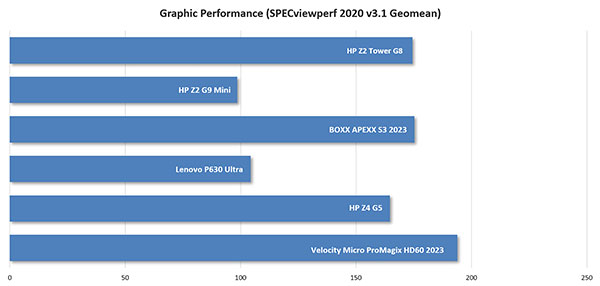
Graphic Performance chart based on SPECviewperf 13 Geomean. Click here for full-size image.
The P-cores have a maximum turbo boost of 5.4GHz, while the E-cores have a maximum turbo speed of 4.3GHz. Total single-core maximum CPU speed is 5.8GHz using Intel Turbo Boost Max Technology 3.0 and Intel Thermal Velocity Boost. Based on the latest Intel 7 lithography, the CPU has a 38MB Smart Cache, a processor base power of 125 watts, and a maximum turbo power of 253 watts. This CPU also includes Intel UHD Graphics 770 and supports ECC memory.
Graphics and Storage Galore
While the latest base HD60 configuration includes an entry-level NVIDIA Quadro graphics card, Velocity Micro offers a choice of 17 different graphics processing units (GPUs) from AMD and NVIDIA, ranging from GeForce RTX boards to the ultra-high-end RTX A6000. Our system came with an NVIDIA RTX A4500, which added $1,050.
This GPU, based on NVIDIA’s GA102 Ampere graphics processor, comes with 20GB of GDDR6 ECC memory and features 7,168 compute unified device architecture (CUDA) cores, 224 Tensor cores and 56 RT (raytracing) cores. Its 320-bit interface yields a bandwidth of 640GB/second while consuming 200 watts. Although it is a single-slot card, it does require additional power via an eight-pin auxiliary connection. The RTX A4500 provides four DisplayPorts.
The ASUS motherboard also includes three M.2 drive sockets and eight SATA 6Gbs ports. While the base ProMagix HD60 configuration includes a 500GB Crucial M.2 drive, our evaluation unit came with a 1TB Samsung 990 Pro PCIe 4.0 NVMe M.2 solid-state drive (SSD) with up to 7450 MBps read and 6900 MBps write capability, adding $60 to the base price. Other SSDs with up to 4TB capacity as well as 7200rpm SATA drives are also available.
Award-Winning Performance
Because previous Velocity Micro systems have typically set new high-water marks in performance, we expected their newest computer to do quite well. And indeed, this updated ProMagix HD60 workstation again delivered some of the best scores we have ever recorded. On our SPECviewperf benchmark, which focuses on graphic performance, the ProMagix HD60 turned in the top scores on seven of the eight datasets.
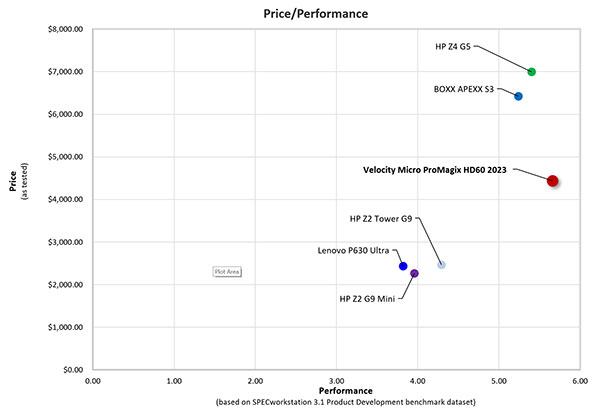
Similarly, on the very demanding SPEC workstation performance benchmark, it garnered top scores on five of the seven focused workloads, including Product Development, on which we base our price/performance calculations. On our own AutoCAD rendering test, which clearly shows the advantages of fast CPUs with multiple cores, the new Velocity Micro ProMagix HD60 broke all previous records, averaging just 10.3 seconds to complete our test rendering, nearly 4 seconds faster than the previous record holder.
Windows 11 Pro now comes standard, although you can downgrade to Windows 11 Home, pay $70 more for Windows 10 Pro or save $80 by ordering the system without an OS and install your own.
Since Velocity Micro does not include a mouse or keyboard unless you specifically add them to your order, we included a basic Microsoft USB keyboard ($20) and optical mouse ($20) in our as-tested price. The standard Velocity Micro warranty only covers the system for one year. Since most original equipment manufacturers back their workstations for 3 years, our as-tested price also includes a $399 charge to extend the coverage to 3 years for parts, labor and depot repair service. Velocity Micro workstations include a lifetime upgrade plan that allows you to return your system for maintenance, upgrades and testing.
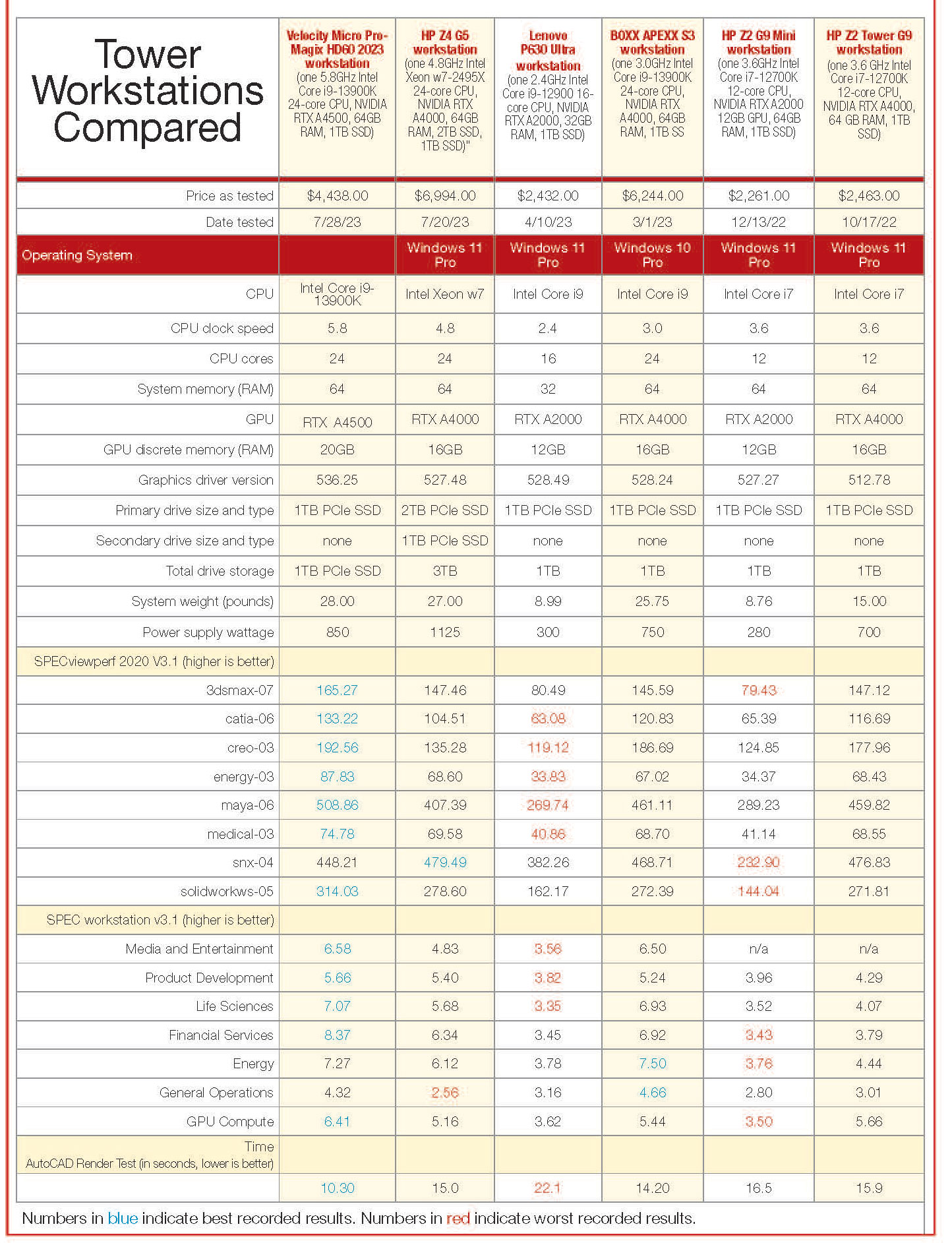
As configured, our system priced out at $4,438, about 25% more than if you simply purchased the components and assembled the system yourself. We think that is a reasonable premium to pay for the peace of mind of knowing that the system was assembled by trained technicians and guaranteed to work when it shows up at your door.
Though equipped with certified hardware, the system lacks independent software vendor certification. If that is not an issue for you, Velocity Micro has again proven that it knows how to assemble high-end workstations. Once again, this new Velocity Micro ProMagix HD60 workstation is the new price/performance winner.
More Velocity Micro Coverage
Subscribe to our FREE magazine, FREE email newsletters or both!
Latest News
About the Author
David Cohn is a consultant and technical writer based in Bellingham, WA, and has been benchmarking PCs since 1984. He is a Contributing Editor to Digital Engineering, the former senior content manager at 4D Technologies, and the author of more than a dozen books. Email at [email protected] or visit his website at www.dscohn.com.
Follow DE





